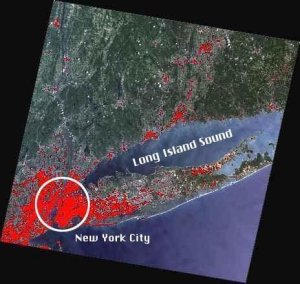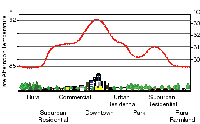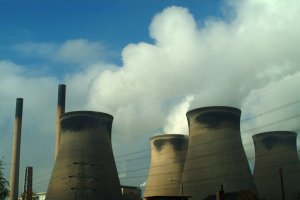|
|
 |
|
|
|
 |
| |
|
|
 |
Climate in cities
Basics |
Urban heat island
A city is built mainly of concrete, asphalt, bricks and stones. As air temperature at a certain place depends to a large extent on the surface character, the temperature in a city is higher than in a non-urban area. The urban heat island is also caused by large number of habitants and anthropogenic heat emission. |
|
|
|
|
 |
In many cities, air temperature is higher than in the surrounding non-urban areas by 0.5-0.8°C on average, and in winter even 1.1-1.6°C. That phenomenon is named urban heat island (UHI). The isotherms (i.e. lines on the map which connect the points of the same temperature) showing city's temperature have the shape of circles, with values decreasing toward city's suburbs. UHI is not homogenous but usually consists of a few parts occurring above the areas favourable for their appearance, e.g. city centre, huge factories, power plants. Its range and intensity varies, therefore it has a cellular structure.
|
 |
 |
 |
|
1. Heat Island map of the New York
Please click picture to see the hottest surfaces, overlaided in red! (35 K)
Source: System for World Surveillance, Inc.
|
|
 |
 |
|
2. Dependence of maximum intensity of UHI on the number of habitants of a city
Please click to see enlarge! (92 K)
Authors: Anita Bokwa, Pawel Jezioro
|
|
 |
The number of habitants is a decisive factor conditioning the occurrence of UHI. In cities with the population of 500,000-1,000,000, air temperature is usually higher by 1.1-1.2°C than in the surrounding non-urban areas. For the cities with more than 1 million habitants the value increases up to 1.2-1.5°C. However, the maximum observed differences are much higher (see the figure).
|
 |
 |
|
3. Sketch of an Urban Heat-Island Profile
Please click to see enlarge! (8 K)
Source: Heat Island Group
|
|
 |
The size and spatial structure of a city are also of great importance, as urban areas with low buildings spread among green areas do not form typical urban heat islands. The phenomenon of UHI is also closely related to the factors already discussed in chapter "Factors controlling...", i.e. anthropogenic heat emission, air pollution and the changes in natural surface's coverage. All of them contribute to the temperature rise in urban areas. Moreover, the intensity of UHI (i.e. the value of air temperature difference between the city and the surrounding non-urban areas) depends on many meteorological elements and phenomena, like wind speed, cloudiness, evapotranspiration. The increase of wind speed and cloudiness may weaken the intensity of UHI.
|
The intensity of UHI changes in yearly and daily cycle. In winter, it may be twice as large as in summer due to emission of anthropogenic heat caused by heating the buildings. Higher intensity of UHI is observed in night than in day-time as during the night intensive radiation from the surface into the atmosphere takes place. Additionally, e.g. for Tokyo it was observed that during weekends and holidays the intensity of UHI decreases.
|
 |
 |
 |
|
4. Emission of anthropogenic heat - cars
photo: Sebastian Wypych
|
|
 |
 |
|
5. Emission of anthropogenic heat - cooling towers
Source: www.freefoto.com
|
|
 |
Apart from the horizontal range, the UHI has also a certain vertical structure. Usually it reaches 200-300 m above the ground, which is about 3-5 times the height of the buildings. At cloudless sky it may reach even 500 m. Two strata may be distinguished:
1. urban canopy layer, where the heat is delivered by the chimneys of houses (the so-called low emission) and from the buildings themselves (as they absorb lots of solar radiation and then emit out the heat), and also from the transportation
2. chimney layer, placed above urban canopy layer, where the heat is delivered by the so-called high emittors, e.g. the chimneys of power plants.
|
|
The occurrence of UHI causes changes in urban climate. In comparison with non-urban areas, there are more hot days and less days with ground frost. The vegetation period is longer, sums of precipitation higher and cumulus clouds are noted more often.
|
|
The phenomenon of UHI has negative impact on human organism, especially in the summer, as it may cause overheating. Therefore, the share of green areas and small water bodies in cities' areas should be increased.
|
|
About this page:
Authors: Sebastian Wypych, Anita Bokwa - Jagiellonian University - Cracow / Poland
Supporter: Anna Gorol
1. Scientific reviewer: Prof. Barbara Obrebska-Starkel - Jagiellonian University - Cracow / Poland - 2003-06-20
2. Scientific reviewer: Dr. Marek Nowosad - Maria Curie-Sklodowska University - Lublin / Poland - 2003-06-16
educational reviewing:
last update: 2004-06-12
|
|
 |
|









